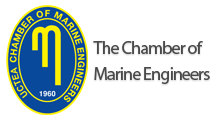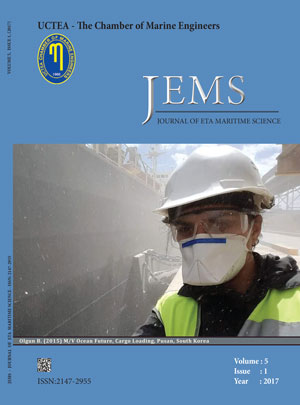

JEMS apply the Creative Commons Attribution NonCommercial 4.0 International Licence to all manuscripts to be published
ABSTRACTING & INDEXING
Volume: 5 Issue: 1 - 2017
| EDITORIAL (ED) | |
| 1. | Changes in Maritime Transportation Selçuk Nas doi: 10.5505/jems.2017.46220 Pages 1 - 4 Abstract | |
| FULL TEXT | |
| 2. | Journal of ETA Maritime Science (Volume: 5 Issue: 1, 2017) Pages 1 - 109 Abstract | |
| ORIGINAL RESEARCH (AR) | |
| 3. | Investigation of Cylinder Pressure Variation Using Stochastic Reactor Model in A Biodiesel Pilot Injection Diesel Engine Operated with Natural Gas Enes Fatih Pehlivan, İsmail Altın doi: 10.5505/jems.2017.88942 Pages 5 - 17 In maritime sector one of the studies made in order to produce ship engines which consider economic and ecologic properties of energy is dual fuel engines. In dual fuel engines, gas fuel-air mixture is ignited with pilot fuel in the combustion chamber. These engines are mostly produced by transforming diesel engines. Combustion characteristics typically include cylinder pressure, heat release rate and ignition delay. These characteristics are acquired through experimental measurements and theoretical approaches. One of the theoretical approaches used is zero dimentional Stochastic Reactor Model. This approach analyzes compression, combustion and expansion processes using probability density function. An engine simulation software based on this approach has been developed and operates by using detailed and reduced chemical kinetic mechanisms of fuels. In this study, the dual fuel engine operated with biodiesel as a pilot fuel and natural gas as a gas fuel was simulated in two optimum pilot injection parameters and different stochastic particle numbers. It has drawn on the study performed on this engine to show the validity of the model. In the most proper pilot injection parameters, it was observed that simulation and experimental pressure values are compatible with each other in specific error rates. |
| 4. | Simulation-Based Analysis of Ship Motions in Short-Crested Irregular Seas Kıvanç Ali Anıl, Devrim Bülent Danışman, Kadir Sarıöz doi: 10.5505/jems.2017.83803 Pages 19 - 38 Demonstration of the seakeeping calculation results other than polar diagrams and Cartesian plots is important during the initial and detail design stages of naval platforms due to the necessity of numerical simulations (time series data) for the design and validation of the systems on board. These time series simulations are called as real time computer experiments. Similar simulation algorithms for ship motions and wave elevation are also used by ship-handling simulators for realistic visualization. The goal of this paper is to create a basis for the simulation-based analysis of ship motions and wave elevation for future design and validation studies for both the naval platform itself and the systems on board. The focus of this paper is the clarification of the theoretical background of this process, i.e. all formulations required to create and validate a ship motion and wave surface simulation are given in detail. The results of this study may also be used in ship-handling simulators or helicopter landing on ship simulations. |
| 5. | A Study on Peception of Seafarers on Private Maritime Security Companies: Perspective of Turkey Taha Talip Türkistanlı, Barış Kuleyin doi: 10.5505/jems.2017.92905 Pages 39 - 58 Maritime piracy, as an asymmetric threat, has caught the whole maritime industry off guard. As anti-piracy measures failed to meet the maritime industrys desired security requirements, private maritime security companies has risen as a new phenomenon. Noting the mentioned developments, a descriptive and partially exploratory research conducted with the purpose of defining the use of privately contracted armed security personnel and discovering the perceptions of Turkish seafarers on this case. Main factors regarding the use of private maritime security companies identified with the literature review. A data collection instrument (questionnaire) constructed and research data gathered by conducting a field research. Data gathered from the Turkish seafarers (n=125) analyzed by various statistical methods such as t-test and frequency analysis. In conculusion, it has been determined that the seafarers think that the privately contracted armed security personnel is an additional measure and will not escalate the violence onboard. It is also noted that there are serious perception differences of seafarers who worked with privately armed security personnel and those who didn't. |
| 6. | Ship Engine Room Casualty Analysis by Using Decision Tree Method Ömür Yaşar Saatçıoğlu, Burak Göksu, Onur Yüksel, Yiğit Gülmez doi: 10.5505/jems.2017.27146 Pages 59 - 68 Ships may encounter undesirable conditions during operations. In consequence of a casualty, fire, explosion, flooding, grounding, injury even death may occur. Besides, these results can be avoidable with precautions and preventive operating processes. In maritime transportation, casualties depend on various factors. These were listed as misuse of the engine equipment and tools, defective machinery or equipment, inadequacy of operational procedure and measure of safety and force majeure (böyle bir kelime yok, yazarlara sorulsun)seffects. Casualty reports which were published in Australia, New Zealand, United Kingdom, Canada and United States until 2015 were examined and the probable causes and consequences of casualties were determined with their occurrence percentages. In this study, 89 marine investigation reports regarding engine room casualties were analyzed. Casualty factors were analyzed with their frequency percentages and also their main causes were constructed. This study aims to investigate engine room based casualties, frequency of each casualty type and main causes by using decision tree method. |
| 7. | A Practical Tool for Evaluating Refrigeration Systems Using R-134a Mehmet Turgay Pamuk, Atilla Savaş doi: 10.5505/jems.2017.19483 Pages 69 - 79 In this theoretical work, the ideal vapor-compression cycle using Refrigerant-134a (Tetrafluoroethane, a chlorine free refrigerant) is studied considering an evaporator pressure range of 100-200 kPa and a condenser pressure range of 0.8-1.6 MPa. The all four states of the thermodynamic cycle are calculated for a great number of conditions within the above pressure ranges. Thermodynamic properties of the refrigerant R-134a are evaluated using curve fitting polynomials. The deviations of the values generated from fitting curves from the actual tabulated data is less than 0.5%. Results are represented in a graph of COP vs. evaporator pressure for various condenser pressures. The results of this study is believed to be a quick reference especially for designers and engineering students. |
| REVIEW (RE) | |
| 8. | The Exclusive Economic Zone In The Eastern Mediterranean: Delimitation Agreements, Stakeholders And Strategies Nur Jale Ece doi: 10.5505/jems.2017.29200 Pages 81 - 94 The Eastern Mediterranean Basin has great geopolitical and geostrategic importance from the points of high potential of energy resources, military, commercial and transportation. Although it was pointed out in the 1982 United Nations Convention on the Law of the Sea (UNCLOS), states that the delimitation of the Exclusive Economic Zones (EEZ)by agreement should be in accordance with international law on an equitable basis; the states in the region declare EEZs unilaterally and enter into bilateral treaties without considering the rights of the third States in order to share the marine energy resources. In the study, importance of geopolitial and geostrategic of Eastern Mediterranean, disputes concerning delimitations of EEZ, the delimitation of maritime juristiction and strategic stakeholders have been examined and it has been proposed for Turkeys strategy on EEZ in Mediterranean And Aegean Seas.. General evaluation has been conducted. The study concluded that Turkey, in order to protect national and other economic interests should declare EEZs in the Mediterranean and Aegean Seas, put forward the charts showing the coordinates of the delimits of its EEZs and sign the delimitation agreements of the EEZ with the coastal states. |
| ORIGINAL RESEARCH (AR) | |
| 9. | Evaluation of Mathematical Models for Tankers' Maneuvering Motions Erhan Aksu, Ercan Köse doi: 10.5505/jems.2017.52523 Pages 95 - 109 In this study, the maneuvering performance of two tanker ships, KVLCC1 and KVLCC2 which have different stern forms are predicted using a system-based method. Two different 3 DOF (degrees of freedom)mathematical models based on the MMG(Maneuvering Modeling Group) concept areappliedwith the difference in representing lateral force and yawing moment by second and third order polynomials respectively. Hydrodynamic coefficients and related parameters used in the mathematical models of the same scale models of KVLCC1 and KVLCC2 ships are estimated by using experimental data of NMRI (National Maritime Research Institute). The simulations of turning circle with rudder angle ±35ᴼ, zigzag(±10ᴼ/±10ᴼ) and zigzag (±20ᴼ/±20ᴼ) maneuvers are carried out and compared with free running model test data of MARIN (Maritime Research Institute Netherlands) in this study. As a result of the analysis, it can be summarised that MMG model based on the third order polynomial is superior to the one based on the second order polynomial in view of estimation accuracy of lateral hull force and yawing moment. |










